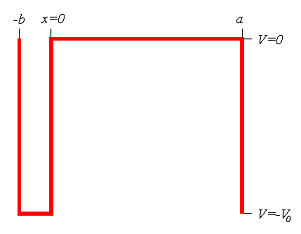Particle in a one-dimensional lattice (periodic potential)
|
|
In quantum mechanics, the particle in a one-dimensional lattice is an idealised system that can be solved completely with some simplifications. The one-dimensional particle lattice is a simplified expansion of the 3D infinite potential barrier (particle in a box). While the "particle in a box" assumes the potential inside the box is 0, it is not the case when looking inside a solid material.
Problem definition
When talking about solid materials, the discussion is mainly around crystals - periodic lattices. Here we will discuss a 1-dimensional lattice of positive ions. Assuming the spacing between two ions is a, the potential in the lattice will look something like this:
Potential-actual.PNG
Image:Potential-actual.PNG
The mathematical representation of the potential is a periodic function with a period a. According to Bloch's theorem, the wavefunction solution of the Schrödinger equation when the potential is periodic, can be written as:
- <math> \psi (x) = e^{ikx} u(x) \;<math>
Where u(x) is a periodic function which satisfies:
- u(x + a) = u(x);
- u(x + a) = u(x).
When nearing the edges of the lattice, there are problems with the boundary condition. Therefore, we can represent the ion lattice as a ring. If L is the length of the lattice so that L >> a, then the number of ions in the lattice is so big, that when considering one ion, its surrounding is almost linear, and the wavefuntion of the electron is unchanged. So now, instead of two boundary conditions we get one circular boundary condition:
- <math> \psi (0)=\psi (L)\, <math>
If N is the number of Ions in the lattice, then we have the relation: aN = L. Replacing in the boundary condition and applying Bloch's theorem will result in a quantization for k:
- <math> \psi (0) = e^{ik \cdot 0} u(0) = e^{ikL} u(L) = \psi (L)\, <math>
- <math> u(0) = e^{ikL} u(N a) \rightarrow e^{ikL} = 1\, <math>
- <math> \Rightarrow kL=2\pi n \rightarrow k= {2\pi \over L} n \qquad \left( n=0, \pm 1, \pm 2, ..., \pm {N \over 2} \right).\,<math>
Kronig-Penny model
In order to simplify the problem the potential function is approximated by a rectangular potential:
Potential-approx.PNG
Image:Potential-approx.PNG
Using Bloch's theorem, we only need to find a solution for a single period, make sure it is continuous and smooth, and to make sure the function u(x) is also continuous and smooth.
Considering a single period of the potential:
We have two regions here. We will solve for each independently:
- <math>0
- <math>\Rightarrow \psi = A e^{i \alpha x} + A' e^{-i \alpha x} \quad \left( \alpha^2 = {2mE \over \hbar^2} \right)<math>
- <math>-b
- <math>\Rightarrow \psi = B e^{i \beta x} + B' e^{-i \beta x} \quad \left( \beta^2 = {2m(E+V_0) \over \hbar^2} \right)<math>
In oder to find u(x) in each region we need to manipulate the probability function:
- <math> \psi(0
- <math> \Rightarrow u(0
- <math> \Rightarrow u(0
And in the same manner:
- <math> u(-b
To complete the solution we need to make sure the probability function continuous and smooth, i.e:
- <math> \psi(0^{-})=\psi(0^{+}) \quad \psi'(0^{-})=\psi'(0^{+}) <math>
And that u(x) and u'(x) are periodic
- <math> u(-b)=u(a-b) \quad u'(-b)=u'(a-b).\, <math>
There conditions yield the following matrix:
- <math> \begin{pmatrix} 1 & 1 & -1 & -1 \\ \alpha & -\alpha & -\beta & \beta \\ e^{i(\alpha-k)(a-b)} & e^{-i(\alpha+k)(a-b)} & -e^{-i(\beta-k)b} & -e^{i(\beta+k)b} \\ (\alpha-k)e^{i(\alpha-k)(a-b)} & (\alpha+k)e^{-i(\alpha+k)(a-b)} & -(\beta-k)e^{-i(\beta-k)b} & (\beta+k)e^{i(\beta+k)b} \end{pmatrix} \begin{pmatrix} A \\ A' \\ B \\ B' \end{pmatrix} = \begin{pmatrix} 0 \\ 0 \\ 0 \\ 0 \end{pmatrix} <math>
In order for us not to have the trivial solution, the determinant of the matrix must be 0. After playing a bit with the determinant we get the following expression:
- <math> \cos(k a) = \cos(\beta b) \cos[\alpha(a-b)]-{\alpha^2+\beta^2 \over 2\alpha \beta} \sin(\beta b) \sin[\alpha(a-b)] <math>
In order to further simplify the expression, we will perform the following approximations:
- <math> b \rightarrow 0 \ ; \ V_0 \rightarrow \infty \ ; \ V_0 b = \mathrm{constant}<math>
- <math> \Rightarrow \beta b \rightarrow 0 \ ; \ \beta^2 b = \mathrm{constant} \ ; \ \alpha^2 b \rightarrow 0 \ ; \ \sin(\beta b) \rightarrow \beta b \ ; \ \cos(\beta b) \rightarrow 1 <math>
The expression will now be:
- <math> \cos(k a) = \cos(\alpha a)-P{\sin(\alpha a) \over \alpha a} \qquad \left( P={\beta^2 a b \over 2} \right) <math>

